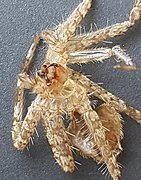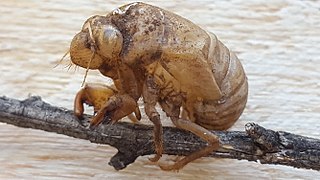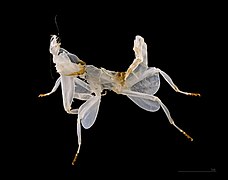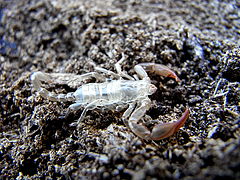In biology, exuviae are the remains of an exoskeleton and related structures that are left after ecdysozoans (including insects, crustaceans and arachnids) have molted. The exuviae of an animal can be important to biologists as they can often be used to identify the species of the animal and even its sex.
As studying insects, crustaceans, or arachnids directly is not always possible, and because exuviae can be collected fairly easily, they can play an important part in helping to determine some general aspects of a species' overall life cycle such as distribution, sex ratio, production, and proof of breeding in a habitat. Exuviae have been suggested as a "gold standard" for insect monitoring. For instance, when monitoring dragonfly populations, the presence of exuviae of a species demonstrates that the species has completed its full life cycle from egg to adult in a habitat. However, it has also been suggested that the fact that exuviae can be hard to find could lead to an underestimation of insect species compared to, for example, counting adult insects.
The Latin word exuviae, meaning "things stripped from a body", is found only in the plural. Exuvia is a derived singular form, although this is a neologism, and not attested in texts by Roman authors. A few modern works use the singular noun exuvium (e.g.). Only a single historical work by Propertius uses the singular form exuvium, but in the meaning "spoils, booty".
Gallery
-
 Anyphops
Anyphops
-
 Cicada Platypleura
Cicada Platypleura
-
 Accelerated view of a cicada molting
Accelerated view of a cicada molting
-
 Orchid mantis
Orchid mantis
-
 Scorpion
Scorpion
-
 Dragonfly Anax imperator
Dragonfly Anax imperator
-
 Large milkweed bug
Large milkweed bug
-
 Emergent monarch butterfly clinging to exuviae
Emergent monarch butterfly clinging to exuviae
References
- Raebel, Eva M.; Merckx, Thomas; Riordan, Philip; Macdonald, David W.; Thompson, David J. (2010-02-25). "The dragonfly delusion: why it is essential to sample exuviae to avoid biased surveys". Journal of Insect Conservation. 14 (5): 523–533. doi:10.1007/s10841-010-9281-7. ISSN 1366-638X.
- BRIED, JASON T.; D’AMICO, FRANK; SAMWAYS, MICHAEL J. (2011-09-19). "A critique of the dragonfly delusion hypothesis: why sampling exuviae does not avoid bias". Insect Conservation and Diversity. 5 (5): 398–402. doi:10.1111/j.1752-4598.2011.00171.x. ISSN 1752-458X.
- "Charlton T. Lewis, An Elementary Latin Dictionary, exuviae". Retrieved July 25, 2016.
- "Exuviae". Lewis and Short Latin Lexicon. The Archimedes Project. Archived from the original on 4 March 2016. Retrieved 21 September 2014.
- "The final instar exuvium of Pycna semiclara Germar, 1834 (Hemiptera: Cicadidae)" - John M. Midgley, Nicolette Bouwer and Martin H. Villet
- "Charlton T. Lewis, An Elementary Latin Dictionary, exuvium". Retrieved July 25, 2016.
External links
| Spiders | ||
|---|---|---|
| Arachnology |  | |
| Taxonomy | ||
| Anatomy | ||
| Human interaction | ||
| Webs | ||
This insect anatomy–related article is a stub. You can help Misplaced Pages by expanding it. |